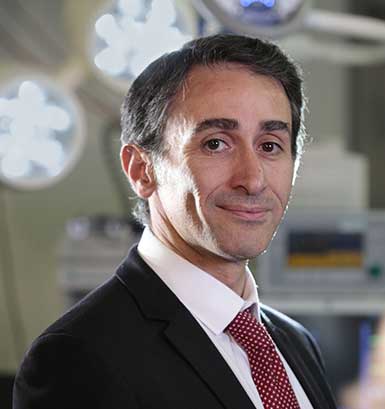
Omar Haddo is a Consultant in orthopaedics, shoulder, elbow, hand and wrists. He qualified in 1996 at St Bartholomew’s Medical School in London, during this time he undertook a BSc in Clinical Sciences at St Mary’s Hospital, London.
He was appointed to the Stanmore Orthopaedic Training Programme in 2002. His training gave him the opportunity to experience many aspects of orthopaedics, to include peripheral nerve repair, paediatric orthopaedics, and bone tumour surgeries, carried out at London’s infamous Great Ormond Street Children’s Hospital together with the Royal National Orthopaedics Hospital in Stanmore. He has a strong interest in helping people with a wide number of upper limb conditions.
Clinical Director, Hily Perpinyal interviews Mr Omar Haddo…
Q) What are the most common injuries you come across related to the shoulder and elbow?
These very much vary around the time of year. In winter, I certainly see a large number of skiing injuries. These are mainly fractures of the collar bone, the humerus and the elbow, but also shoulder dislocations. However, in the summer, the injuries seem to be more around fractures in children, especially around the first week of the summer holidays. Otherwise the commonest injuries all year round, tend to be traumatic cuff tears and shoulder dislocations. Elbow injuries are a lot rarer and the majority are fractures.
Q) It can often be difficult to know the cause of arm pain. Sometimes one may think the pain comes from the shoulder, but it often starts at the neck. What processes do you go through to diagnose the pain?
There is certainly a large cross over between shoulder and neck pathology. In general terms, shoulder pain is usually concentrated around the shoulder and the upper arm. It is made worse with certain shoulder movements and does not usually radiate to the forearm or hand. Also, usually there are no associated pins and needles or numbness in the hand with this. However, there are always exceptions and, in my experience, frozen shoulder in particular can have variable presentation. For this reason, it is important for the patient to be examined. We have all learned to adapt over the period of the pandemic and video consultations have become the norm, however, for new patients, I think there is no substitute to a good history and examination.
Q) How long do you recommend pain should be self-managed before one decides to seek further help?
In my opinion, if there is a history of injury then patients should present early. This is often not an issue for fractures but with traumatic cuff tears. I think if the patient still cannot lift their arm up 2-3 weeks after an injury, then assessment of the rotator cuff is required. If the onset of pain is spontaneous however, then seeking help I find is usually based on severity of the pain. Those patients in agony (eg calcific tendinitis) tend to present earlier than those with impingement type pain. Impingement pain can be managed conservatively for at least 6-8 weeks before presenting to a surgeon.
Q) Steroid injections are often used to relieve pain for various conditions related to the shoulder and elbow, including rotator cuff injuries, frozen shoulders, tennis elbow. If recurring injections are required for pain relief, how many can one have per year and how often can they be given?
We are moving away from steroid injections as much as we can, and certainly from repeated injections. While there are other options on offer out there, I am not aware of any current literature showing benefits of these alternatives. My current policy is one subacromial injection only for bursitis or tendinitis and only consider a second based on many factors (response to first injection, time since last injection, underlying condition).
For frozen shoulder, I do refer patients for hydrodilation, which includes a steroid injection, and these are mostly one-off injections but rarely can repeated once more.
As for tennis elbow, the literature is clear that steroid injections are not recommended. Conservative management should be pursued and if injection is needed then consider PRP (protein rich plasma). That said, there are very few patients that present with severe pain and disability from tennis elbow. Those patients I do consider for a one-off steroid injection to allow them to pursue conservative treatment.
Q) Most patients are fearful of having surgery and understandably want to avoid it for as long as possible. However sometimes there comes a point when one seriously needs to consider this option if symptoms are not improving. At what stage does one need to consider having surgery for arm pain?
This very much depends on what the diagnosis is. Most shoulder conditions can and should be treated conservatively first, and for as long as the patient is able to tolerate the symptoms. Surgery in those conditions should only be a final choice and only once the patient has been made aware of the risks and the recovery period. The majority of patients are happy to try rehabilitation first and only seek surgery if their pain remains severe or if the symptoms impact on their daily activities. However, certain diagnoses, such as traumatic rotator cuff tears or recurrent shoulder dislocations should seek early advice as certain conditions can be time critical.
A special thank you to Mr Haddo for taking the time to give us a great insight into upper limb pain.
For more information about Mr Haddo please visit www.shouldersurgery.london
